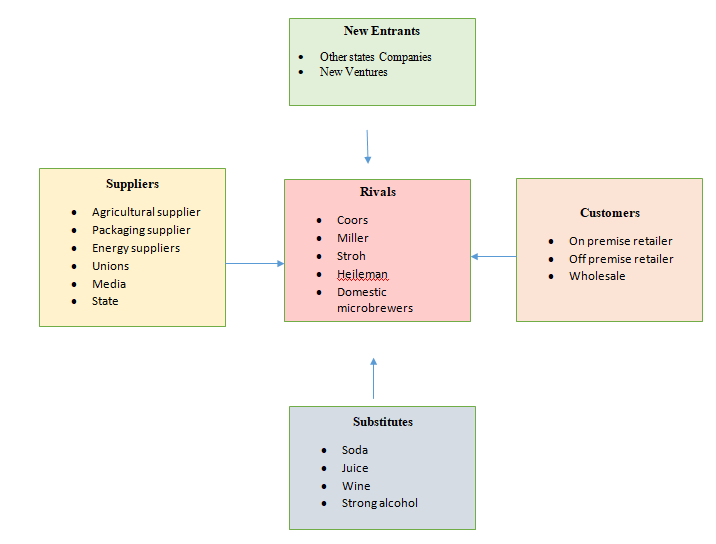Adolph Coors en el sector Case Study Solution
Porters
Analysis
The Average threat of new entry is low
There are number of reasons, the brewing industry faces a low risk of new entrants.The first is the prohibitively high entrance fees. A new entrant wants relationships with various suppliers on the market, such as raw material suppliers and packaging suppliers, to manufacture and distribute beers.Furthermore, there would need a significant amount of money to purchase the requisite machinery and services to manufacture the beer. Controlling the fermentation mechanism often necessitates the creation of knowledge. The brewing businessesthat wish to extend their business to other states of the United States, are more dangerous. They already have a brand name as well as the necessary resources to reach the market and gain a massive market share.
High bargaining power of customers
Customers have strong negotiating power because of the importance of competition and the variety of beer types available.The wholesalers are the key buyers, with which the brewing firms partner together in order to retain market share. They have the ability to encourage or to not promoting any brand, which makes them extremely strong. On the other hand, on premise retailers like bars and restaurants, as well as off-premise retailers like supermarkets and groceries, lack significant bargaining power. Since they are less lucrative for the brewing industries, they have less control. Furthermore, one-premise stores make a lot of money on profits (an average margin of 190 percent in 1985) and are dependent on the brand that their consumers want.
The low bargaining power of suppliers
First and foremost, farm suppliers do not have good negotiating power because the cereals used in the beer recipe are not rare and are readily available.When beer firms decided to develop their own canning plants, the manufacturing manufacturers, which supplied cans and bottles, lost their influence. Furthermore, as shown during the Coors strike, workers do not have strong bargaining power.Furthermore, since advertising campaigns rarely last more than a year, the media has little influence on industry, although this could change as more consumers begin to watch television.
The energy provider, on the other hand, has significant bargaining power and they could not manufacture anything without them. After the oil crises of the 1970s, breweries were well aware of this.States wield considerable influence because they are in charge of distributing water rights, tax reform, and permits to prepare alcoholic beverages. The minimum drinking age in each state is also defined.
Low threat of substitutes
In the brewing industry, substitutes do not face a major threat. Of course, consumers could order other products, such as: juice or soda, but these have been around for a long time and have not posed a challenge to the brewing industry. Furthermore, these beverages do not contain alcohol and have a distinct aroma. Wine and other powerful alcoholic beverages, on the other hand, can pose a challenge.
High competition
In America, the industry of beer is now mature enough, sales stabilized in year 1983. There a plenty of the competitors offering various types of beer and catering to a wide range of demographics. In addition to the major brewers, there are small local microbreweries which lack the necessary packaging and manufacturing technologies to compete with the major brands.
Competitive landscape
Brewers in the United States often use ingredients to conserve foam to keep beer fresh, while brewers in Europe do not. To guarantee that the remaining yeast does not waste, almost all bottled and canned beer is pasteurized in the bottle. Unpasteurized draught beer must be kept refrigerated to avoid spoilage. In taverns, pubs, and other restaurants, it is served from large kegs.
Three big corporations dominate approximately 80% of the industry in the United States. Miller is in second place, with Miller Light being the third most popular commodity. Coors Brewing Company is ranked seventh, with Coors Light being the fourth most popular beer.
The biggest competitor is Anheuser-Busch.
Strengths
- They have easy access to customers
- Cannot be brought to a halt by an incident in a brewery
- Customers recognize the firm
- Many segments are targeted.
- Can keep their beers in store for a long time
- Transportation expenses are minimal.
Weaknesses
- It is not present on media
- Don't optimize on manufacturing costs.
- Other than its capital, it has little power.
- Relying on manufacturers of cans and bottles
- There are no special distributors.
Pest
Political
First and foremost, taxes have an influence on the industry. These did, in effect, grow to 12% per barrel at one point. In the United States, various states have different age restrictions on the selling and consumption of alcohol.Furthermore, the companies needed permits in order to prepare and distribute alcohol. Restaurants and bars are expected to market it in the same way. States and federal laws control these activities.The Federal Commission is also placing pressure on the beer industry and the US Department of Health and Human Services. In reality, they are checking facilities on a daily basis in order to keep track on the brewing firms. Companies require water rights to use water in the brewing process...............
Adolph Coors en el sector Case Study Solution
This is just a sample partial case solution. Please place the order on the website to order your own originally done case solution.














